Assault artillery: StuG III and its descendants
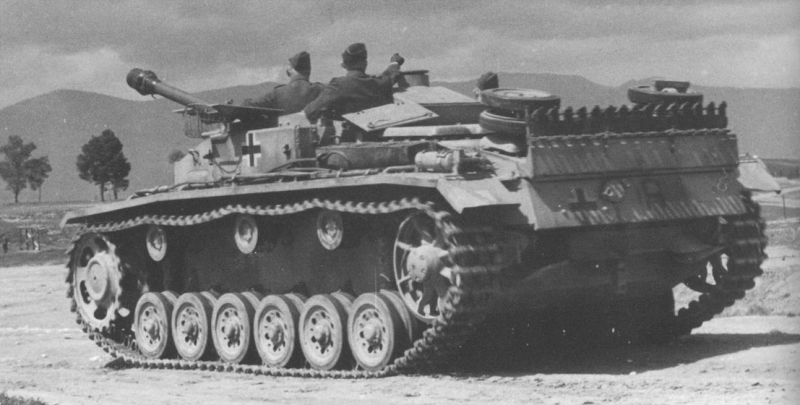
StuG III Ausf. F / 8 in Tunisia. Source: Panzer Tracts
Speaking of World War II, we are used to the fact that the most important and massive tracked armored vehicles usually seem Tanks. These are primarily Soviet T-34s and American Shermans. But self-propelled guns were on the sidelines. And really, what is 5 SU-100s compared to 31 T-34-85s?
However, in Germany the situation is different. The most massive tracked armored vehicle among the Germans was the StuG III - together with the StuH 42, 10,5 thousand of them were produced. Only StuG III Ausf. G assembled 7 vehicles - more than all the "long-barreled" Pz. Kpfw. IV combined.
StuG III not only became the most massive, but also gave rise to a number of other German self-propelled guns. And not only German ones - with an eye on the StuG III, the Italian Semovente da 75/18, the Hungarian Zrinyi, as well as the Soviet SU-122 were created.
In this article, we will trace the path from the idea of the future StuG III to the final plans of Nazi Germany in 1945.
Creation of assault artillery
The French campaign of 1940 was not just a battle between German tanks and French. Different doctrines clashed on the battlefield. The Germans assembled tanks in large groups, created an advantage and seized the initiative. But the French infantry command "smeared" the tanks over the infantry units in small groups. True, the cavalrymen disposed of their equipment much more reasonably, but this could not turn the tide of the war.
We know that the German approach was better. But this does not mean that the infantry can be left without support. Back in June 1936, the future Field Marshal Erich von Manstein, then a colonel, proposed a new look weapons - assault artillery, in German Sturmartillerie.
Unlike tanks, assault guns (Sturmgeschuetze) operated in small groups and were assigned to infantry units. Their main task is to follow the infantry into the attack and cover it with fire, hitting enemy machine guns and tanks with direct fire. These requirements determined the features of assault guns: powerful frontal armor, a closed wheelhouse, a small gun elevation angle, and the optional presence of a machine gun.
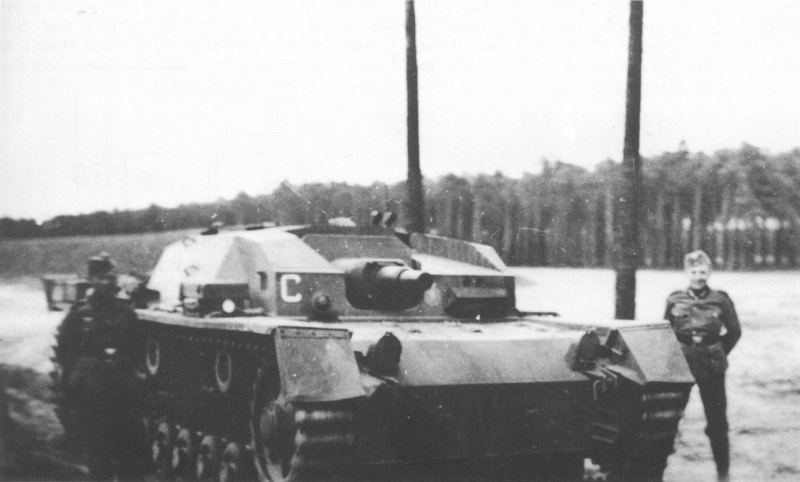
One of the first five prototypes of the Pz. Sfl. III on the Pz. Kpfw. III Ausf. B. Source: Panzer Tracts
Von Manstein's proposal solved several problems at once. The infantry received mobile and protected artillery - something that it lacked so much during the First World War. The crews of the assault guns trained separately from the tankers, so each type of weapon was used according to its own doctrine. Finally, a serious dispute was resolved by itself. General Oswald Lutz advocated the independent use of tanks, with which the more conservative Chief of Staff, General Ludwig Beck, disagreed. After the creation of assault artillery, the supporters of General Beck were calm about the technical equipment of the infantry.
Work on the assault gun began on June 15, 1936. They didn’t reinvent the wheel - Daimler-Benz was given the task of installing a wheelhouse on the Pz. Kpfw. III, and Krupp redesigned the 75-mm Pz. Kpfw. IV under the cabinet. By the fall of 1939, five experienced assault guns Pz. Sfl. III on the Pz. Kpfw. III Ausf. B. These machines were used only for training, as their cuttings were made of mild steel.
So began story Stug III.
The most massive
Chassis Pz. Kpfw. III Ausf. B with weak armor and spring suspension was only a temporary measure. A large series of Sturmgeschuetz was planned based on the new ZW.38 chassis with torsion bar suspension. It promised enhanced armor and high speed, but problems with a tricky transmission and bad tracks thwarted the plan. The Germans wanted to release a series of 96 Pz. Kpfw. III Ausf. E by September 1938, but only one car was delivered for the whole year. And this is on the eve of a big war! There was an acute shortage of tanks, in addition, serious childhood illnesses got out of the released cars.
In general, the ZW.38 project was still a technical adventure, but this topic deserves a separate article.
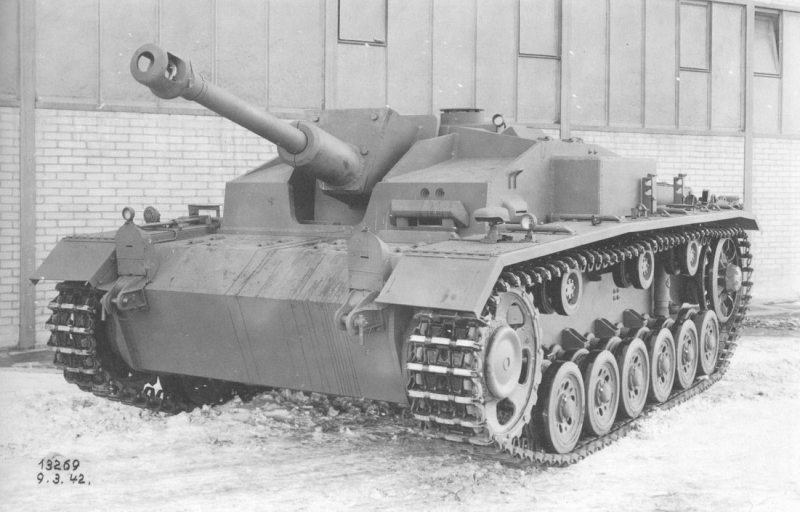
The first StuG III Ausf. F with a long gun, 9 March 1942. Source: Panzer Tracts
Problems with the production of tanks were also reflected in the production of StuG III, because there was simply not enough chassis for self-propelled guns. The first self-propelled guns StuG III Ausf. A managed to make war in France in 1940 and showed themselves very well. Further, the Germans produced assault guns in small batches, gradually improving the chassis. This went on until the autumn of 1941, when German specialists inspected the T-34 and KV-1 tanks near Moscow. Soviet innovations made it clear that all German tanks were outdated in terms of armor and weapons. This also applied to the StuG III with its 75 mm "cigarette butt".
The solution was found quickly. In the wheelhouse StuG III Ausf. E installed a 75-mm StuK 40 gun with a 43-caliber barrel, similar to the new Pz. Kpfw. IV. Already in March 1942, the production of StuG III Ausf began. F "with a long arm". Now German self-propelled guns could hit any Soviet tank. And in December, the last, most massive series of StuG III Ausf appeared. G. Frontal armor was increased from 50 to 80 mm and a commander's cupola was added. In this form, assault guns were produced until the end of the war.
In other countries
The Soviet military did not immediately see the potential of assault artillery. They knew that the Germans had used new weapons in France, but did not attach much importance to this. In the autumn of 1941, the StuG III hit Kubinka for the first time, but even with the trophy in front of their eyes, the Soviet specialists at first made, to put it mildly, strange conclusions. They mistakenly defined the role of self-propelled guns and clearly underestimated them:
<...>
The armor protection of the tank is affected by artillery of all calibers.
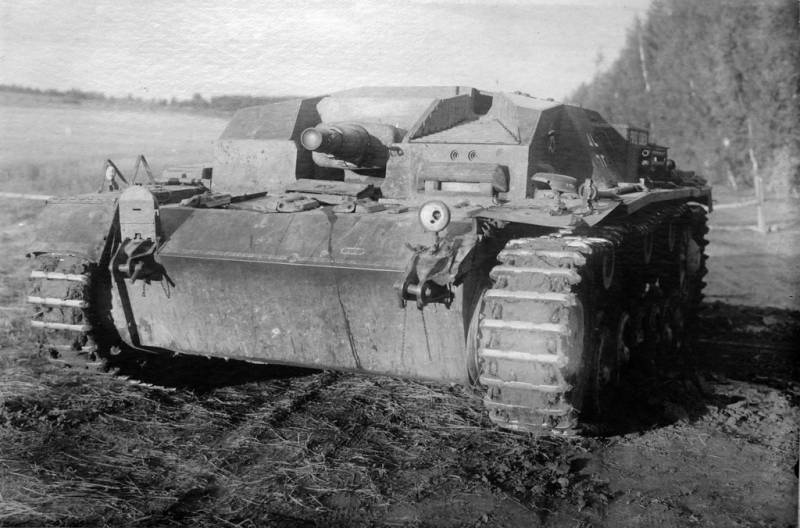
Captured StuG III Ausf. B in the Soviet Union. Source: warspot.ru
Very belatedly, in September 1942, fire tests were carried out. It turned out that the Soviet 45 mm gun could not penetrate the 50 mm frontal armor even at close range. The British "two-pounder" was also useless. The American 37mm cannon was still able to penetrate the StuG III head-on from 100 meters, and only the Czech 37mm cannon confidently worked with sub-caliber shells. The result is quite predictable, because 50 mm is the minimum level of anti-cannon armor. Unlike the German tanks, the StuG III immediately received such frontal protection.
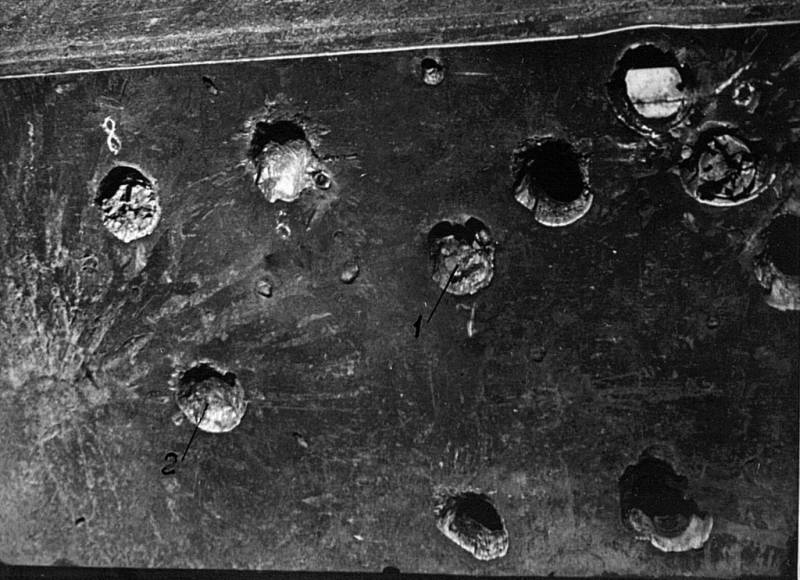
The result of shelling, 1 and 2 - non-penetration of 45-mm shells. With the vulnerability of StuG III, Soviet specialists clearly got excited. Source: warspot.ru
There is reason to believe that the StuG III directly influenced the Soviet self-propelled guns. Middle-class self-propelled guns were developed in the USSR even before the war, but they were completely different vehicles - with an 85-mm cannon in open turrets. In April 1942, it was decided to create an assault gun with a wheelhouse. The result was a self-propelled howitzer SU-122 based on the T-34. The machine had serious shortcomings, for example, the extremely low accuracy of cumulative projectiles and separate vertical and horizontal guidance drives. As a result, it did not become mass, but on its basis successful self-propelled guns SU-85, SU-85M and SU-100 were developed.
The StuG III also affected Germany's allies. At the end of 1940, the Italians decided to create their own German-style assault guns. And they did not fail: Italian tanks quickly became outdated, but Semovente M40 da 75/18 self-propelled guns turned out to be perhaps the best model of Italian armored vehicles. They boasted a 75 mm gun and a low silhouette. Later, assault guns Semovente da 105/25 of 105 mm caliber appeared, but the Italians themselves fought little on them. After the Allies landed in Italy, most of the self-propelled guns went to the Germans.
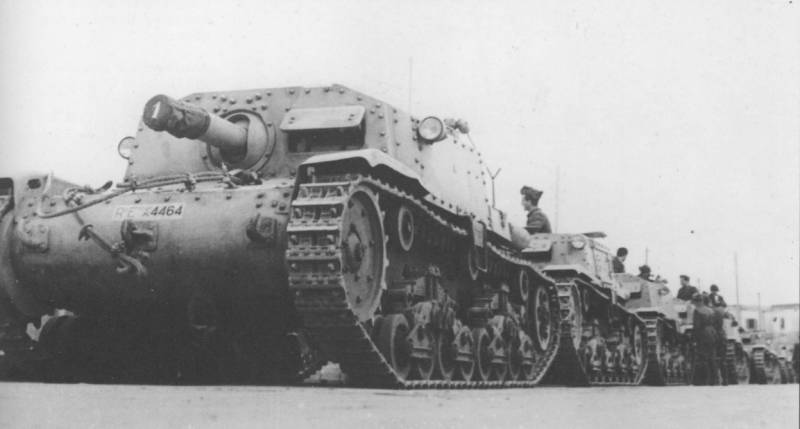
Semovente M40 da 75/18. Source: tanks-encyclopedia.com
In 1942, Hungary also decided to organize its own assault artillery. Hungarian engineers put a wheelhouse with a 105-mm howitzer on the extended chassis of the Turan tank. This is how the 40 / 43M Zrinyi rohmtrack appeared - the Zrinyi assault howitzer. The car turned out to be successful, with a low silhouette, a smooth ride and a planetary transmission.
However, the Hungarian industry was late and could not produce armored vehicles in large quantities. Modification "Zrinyi" with a 75-mm anti-tank gun and did not go beyond one prototype.
In general, the Italian and Hungarian experience shows that the creation of assault guns could extend the life of obsolete chassis and partly make up for the lack of modern tanks.
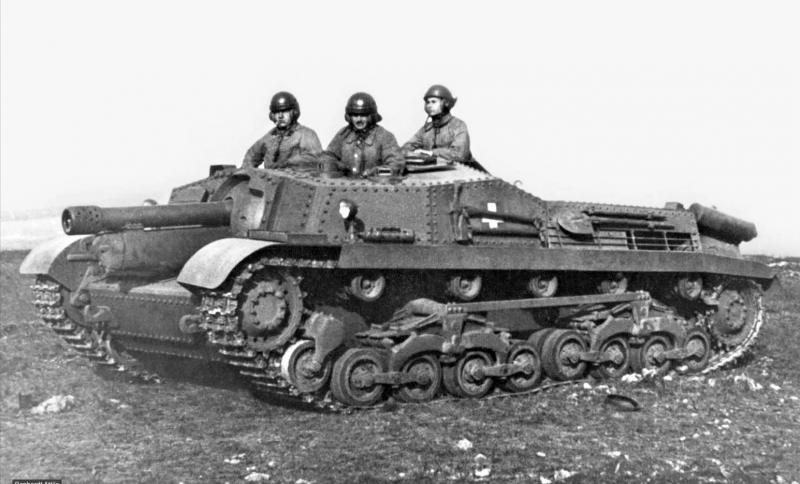
40/43M Zrinyi rohmtrack. Source: reddit.com
Rebranding according to Guderian
In 1942, the Germans decided to create assault guns on other chassis. On the one hand, they saw the successful use of the StuG III. On the other hand, Pz. Kpfw. III was definitively obsolete, and stopping its production was a matter of time. Along with this, the question arose about the prospects for StuG III on the same chassis. In September 1942, Vomag was given the task of developing a new design assault gun based on the Pz. Kpfw. IV – Sturmgeschuetz neuer Art. Against the background of a square-nested predecessor, it looked elegant.
If on the StuG III the gun was mounted on a pedestal, now it is hung on the front plate. This reduced weight and improved protection. Part of the armor plates were placed at an angle, and the total height decreased to 1,86 meters. Finally, in the front sheet provided for the installation of a machine gun. Of all the German self-propelled guns with a 75-mm cannon, the development of Vomag turned out to be the most successful. And at the same time, self-propelled guns were assembled at only one plant, and low-quality armor was used for felling. It is surprising why the Germans treated a successful car with such disdain.
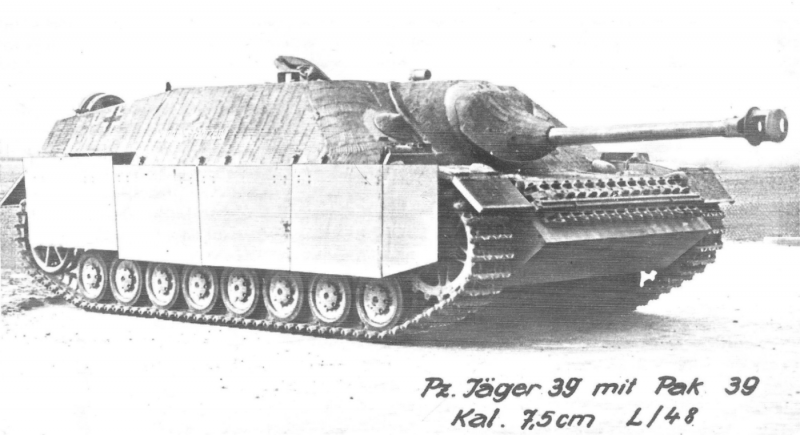
The second sample of the Jagdpanzer IV was later used as a training one. Source: Panzer Tracts
And here readers will notice: what a Sturmgescheutz nA, this is the well-known Jagdpanzer IV! However, the self-propelled gun did not immediately receive the usual name. At first, it passed as an assault gun and was conceived as a complete analogue of the StuG III. However, General Guderian was unhappy with the fact that the new self-propelled guns were subordinated to the infantry, and he got the Marder tank destroyers based on outdated chassis with light armor. Therefore, he defended the renaming of assault guns into tank destroyers. Accordingly, the Sturmgescheutz nA became known as the leichter Panzerjaeger IV, a light tank destroyer. And later the usual name Jagdpanzer IV appeared.
A similar path was followed by other self-propelled guns. At a meeting in September 1942, the future Jagdpanther was called Sturmgescheutz auf Panther. Later it was renamed schwerer Panzerjaeger auf Fgst. The Panther I is a heavy tank destroyer based on the Panther I chassis. Ferdinand and Jagdtiger also originally came out as Tiger-Sturmgeschuetz and schweres Sturmgeschuetz mit 12.8 cm Kanone. Please note: the Germans divided tank destroyers with closed cabins only into light and heavy ones, so the Jagdpanzer IV was called light, and the Jagpanther was called heavy.
As much and as cheap as possible
Throughout the war, German industry could not produce as many tanks as the Allies assembled. Under these conditions, the StuG III took a very important role as a mass, cheaper and simpler substitute for the Pz. Kpfw. IV. The Alkett and MIAG factories continued to increase their production rates and in October 1942 almost 400 StuG IIIs were delivered. However, a month later, the Allies bombed the Alkett workshops, and the production of self-propelled guns sank sharply. The Germans in the shortest possible time set up the assembly of the StuG IV, redoing the wheelhouse of the StuG III under the Pz. Kpfw. IV, but it was only a temporary solution. For the production of self-propelled guns, a spare platform was required.
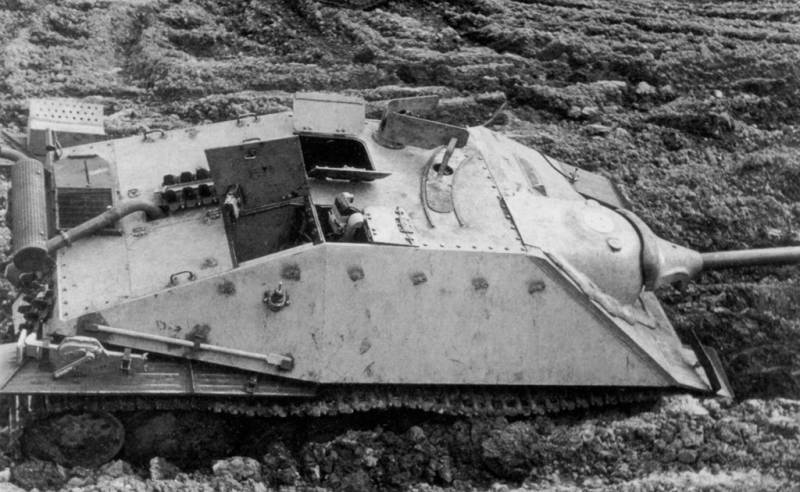
Jagdpanzer 38 in its natural habitat. Notice how inconvenient the commander's seat is. Source: warspot.ru
Then the Germans turned to the Czechs. At the BMM plant, which produced the Pz. Kpfw. 38(t) and vehicles based on it, there was no equipment for assembling self-propelled guns of the 20-ton class, so the engineers had to limit themselves to altering the chassis of a light tank. The project was originally called leichtes Sturmgeschuetz auf 38(t) - a light assault gun based on the 38(t), later it was renamed lechter Panzerjaeger 38 and Jagdpanzer 38.
The weak chassis led to a questionable compromise design. The engine was boosted to the limit, but it was still barely enough. The final drives often broke, and the overweight nose required strengthening of the suspension. The jobs were cramped and blind, and the loader was to the left of the gun, which was designed to be loaded from the right. Because of this, reloading turned into an acrobatic performance. Fragile Czech steel easily split, and in terms of silhouette, it seemed like a small self-propelled gun turned out to be even higher than the Jagdpanzer IV.
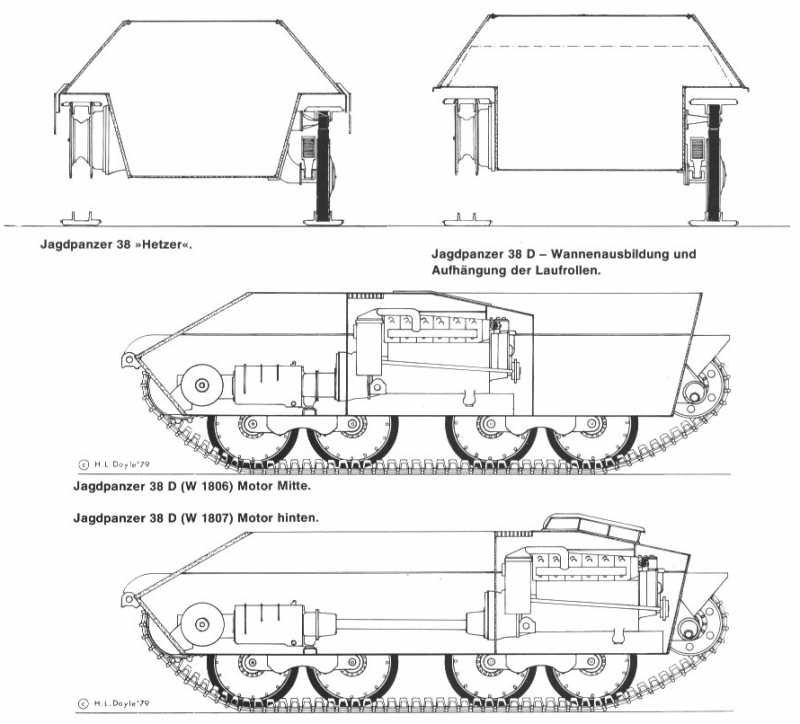
Comparison of Jagpanzer 38(t) and 38 D hulls, as well as engine layout options. Source: Walter Spielberger. Die Panzerkampfwagen 35 (t) Und 38 (t) und ihre abarten (Band 11 der Reihe "Militarfahrzeuge") - 1990
With all its many shortcomings, the Jagdpanzer 38 had a decisive advantage - it could be mass-produced here and now, and at a low price. Given that many of the shortcomings were technically fixable, the light Czech self-propelled gun looked promising. In September 1944, the Germans decided to stop assembling the StuG III at the Alkett factory and start producing the improved lechter Panzerjaeger 38 with a Tatra diesel engine at a rate of 1 vehicles per month.
On October 4, 1944, an even more radical plan arose.
In order to unify production as much as possible, the Germans decided to deal with their "zoo" and leave only three types of chassis: Jagdpanzer 38, Panther and Tiger II. Accordingly, StuG III, StuG IV, Jagdpanzer IV and other self-propelled guns were discontinued, at the same time the Panzerjaeger III / IV program on a single chassis (Einheitsfahrgestell) was terminated.
However, the Czech design was foreign to German factories, so Alkett began the Jagdpanzer 38 D project, the German analogue of the Jagdpanzer 38, correcting its shortcomings. The 38 D chassis received a wider and more spacious body, reinforced suspension, a new gearbox and a 220 hp Tatra diesel engine. With. At this base, it was proposed to assemble tank destroyers, reconnaissance vehicles, ZSU and BREM.
In April 1945, the Germans tried to have time to assemble two Jagdpanzer 38 D prototypes, but the end of the war crossed out all plans.
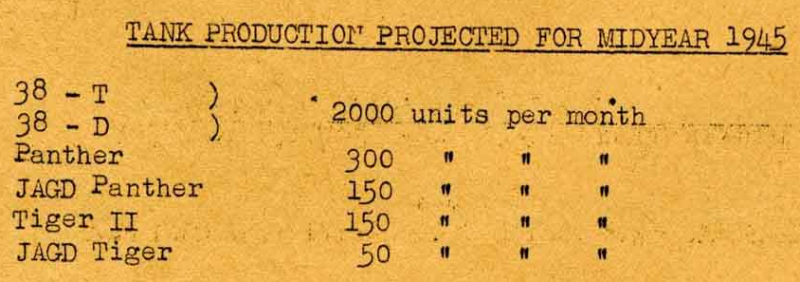
Dreaming is not harmful: plans for the production of armored vehicles in 1945. It can be seen what a big role was assigned to self-propelled guns. Source: Interrogation report of Gerd Stieler von Heidekampf, 28 June 1945
***
We have looked at the path from the idea of assault artillery in 1936 to the latest plans for the German tank industry in 1945. By the middle of the war, the Germans were betting on the mass production of self-propelled guns, and at the end they drew obviously unrealistic plans for 2 light tank destroyers a month. Of course, our story is far from complete. In addition to the usual assault guns, the Germans created a whole line of assault howitzers, which culminated in the monstrous Sturmtigr with a rocket-propelled mortar. However, this topic deserves a separate article.
Sources:
Thomas L. Jentz, Hilary L. Doyle. Sturgmeschuetz: s.Pak to Sturmmoerser (Panzer Tracts Nr. 8) – Darlington Productions, 1999
Thomas L. Jentz, Hilary L. Doyle. Jagdpanzer: Jagdpanzer 38 to Jagdtiger (Panzer Tracts Nr. 9) – Darlington Productions, 1997
Thomas L. Jentz, Hilary L. Doyle. Jagdpanzer: Jagdpanzer IV, Panzer IV/70 (V) and Panzer IV/70 (A) development and production from 1943 to 1945 (Panzer Tracts Nr. 9–2) – Panzer Tracts, 2012
Thomas L. Jentz, Hilary L. Doyle. Paper Panzers: Panzerkampfwagen, Sturmgeschuetz, and Jagdpanzer (Panzer Tracts Nr. 20–1) – Panzer Tracts, 2001
Information